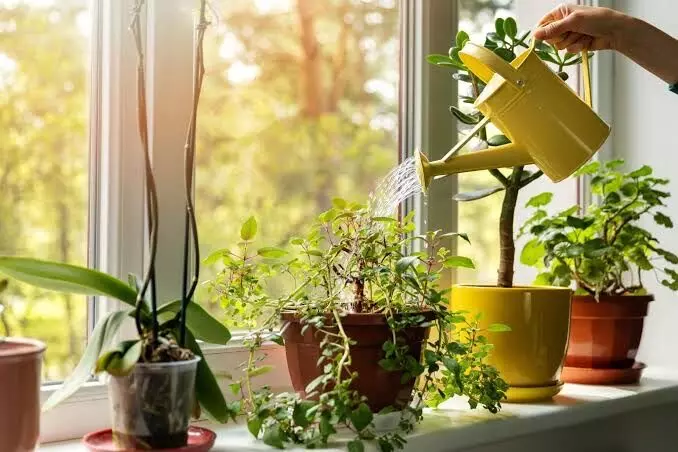Pest control to fertilizing: Here’s a guide to plant care during monsoon
The monsoon can be a time of renewal for your garden, but only with the right practices
By Anoushka Caroline Williams
Pest control to fertilizing: Here’s a guide to plant care during monsoon
Hyderabad: For most gardeners, monsoon rains signal a period of natural watering and lush greenery.
While rain can nourish your plants, it can also bring challenges like waterlogging, fungal infections, pest outbreaks, and nutrient washout. Gardeners, whether hobbyists or professionals, need to adopt a tailored approach to ensure their plants thrive during this season.
Here’s a comprehensive guide to monsoon plant care, with insights from horticulturists and plant experts.
1. Soil and Drainage: Prevent Waterlogging at All Costs
Excessive rainfall can lead to stagnant water in pots or beds, suffocating the roots and causing rot.
“Make sure all your pots have well-functioning drainage holes. You can also place a layer of pebbles or broken terracotta at the bottom to aid water flow,” says Khyati Mehra, a Hyderabad-based landscape designer.
For ground-level gardens, slightly raised beds or sloped surfaces can help rainwater drain away from the plant base. Gardeners should also regularly check for water accumulation and use tools like hoes or small forks to loosen compacted soil.
2. Modify Your Watering Schedule
During the monsoon, nature takes care of irrigation, and overwatering becomes a real threat.
Water only when the top layer of the soil is dry. Even indoor plants might not need daily watering during monsoons due to ambient humidity,” advises Dr. Praveen Reddy, a horticulture professor.
Use your fingers to check soil moisture before watering. If it’s damp an inch below the surface, skip watering for the day.
3. Watch for Fungal Infections and Root Rot
Humidity and lack of sun create ideal conditions for fungal growth, especially on leaves and stems.
“Remove any yellowing, blackened, or spotted leaves immediately. These could be early signs of fungal infection,” says Dr. Reddy.
Neem oil spray, diluted baking soda solutions, or natural fungicides like cinnamon powder can help prevent outbreaks. Avoid watering leaves and focus on the soil base instead.
4. Prune Strategically
Pruning during the monsoon is important, but timing and moderation are key.
“Monsoon is a good time to prune because plants recover quickly. But always prune during dry intervals, never when it’s actively raining or very humid, as cuts are more prone to infection,” says Mehra.
Cut back leggy or dead branches, and avoid dense growth that prevents airflow around the plant.
5. Pest Control: Increased Vigilance Required
Snails, slugs, mealybugs, and other pests multiply during the rains. Their activity is more prominent on soft, damp leaves.
“Check under leaves, especially in potted plants and indoor gardens. Use natural pest control methods like garlic spray or diluted soap solutions regularly,” says Akhil Agarwal, founder of a Hyderabad-based plant nursery.
Setting beer traps or using copper tape around pots can also deter slugs and snails.
6. Sunlight and Placement: Maximise Light Access
Monsoons often bring cloudy days and reduced sunlight, affecting photosynthesis.
“Move indoor or balcony plants closer to windows or open areas to maximise light exposure,” suggests Agarwal.
For outdoor plants, avoid placing pots directly under trees or shade structures that block light and airflow. If necessary, gently rotate pots every few days to ensure even exposure.
7. Fertilising: Less is More
With soil nutrients easily washed away during heavy rains, fertilisation becomes a tricky subject.
“Don’t over-fertilise. Waterlogged soil doesn’t absorb nutrients well, and excess fertiliser can cause root burn. Use slow-release or organic composts during the early monsoon and again after heavy rains subside,” advises Dr. Reddy.
Liquid fertilisers can be added in minimal quantities during dry intervals for better absorption.
8. Support for Tall and Fragile Plants
Heavy rains and wind can damage delicate stems and topple tall plants.
“Use bamboo stakes or plant ties to provide structural support, especially for flowering varieties like hibiscus or ornamental climbers,” says Mehra.
For creepers or vines, check that trellises or supports are secure and not overburdened by wet foliage.
9. Keep the Area Clean
Decaying plant matter, fallen leaves, and standing water create breeding grounds for insects and fungi.
Regular cleaning of pots, saucers, and garden paths is essential. Sweep up leaf litter, remove weeds, and ensure there’s no stagnant water around pots or trays.
10. Ideal Plants for the Monsoon
If you’re planning to grow during the monsoon, some plants naturally thrive in this season.
“Choose native varieties or hardy species like turmeric, ginger, lemongrass, basil (tulsi), coleus, rain lilies, and ferns. These are adapted to high humidity and erratic rainfall,” says Dr. Reddy.
Conclusion
The monsoon can be a time of renewal for your garden, but only with the right practices. Monitor your plants closely, make minor daily adjustments, and stay proactive with preventive care. With mindful gardening, you can enjoy a lush, vibrant green space throughout the rainy season.